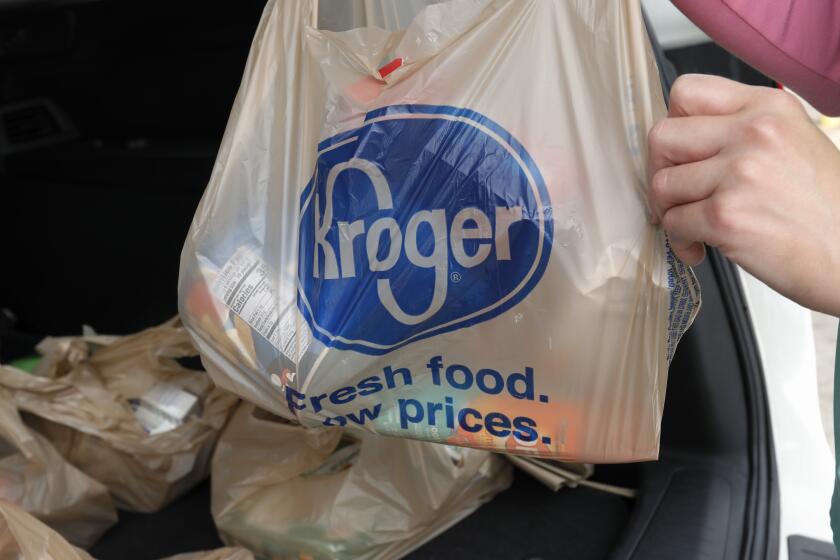Column: Starbucks unveils a private health insurance exchange. Is that a good thing?
To hear Starbucks tell it, the company’s introduction this week of expanded insurance choices for workers represents a major advance in health coverage.
“Providing industry-leading benefits for eligible full- and part-time partners is a cornerstone of who we are as a company,” Ron Crawford, Starbucks’ vice president of global benefits, said in a statement. “Much like a travel site, our partners will be able to navigate an easy-to-use online platform to choose between more insurance carriers and coverage levels at more competitive prices to help them find the right plan for their own needs.”
By switching to a plan “that better meets their individual needs,” the company said, employees could save as much as $800 a year. The savings for those with family plans could reach $2,600 annually, it said.
As I wrote last week, such savings typically come in the form of lower premiums and higher deductibles and co-pays — an option that will be especially attractive to younger, healthier people who see no need for more-comprehensive insurance.
The danger for the U.S. healthcare system is that this can result in higher costs for people desiring, or requiring, stronger coverage. This is known in insurance circles as “adverse selection,” or higher costs for the sick because they’re no longer pooling risk with the healthy.
Last week we could only speculate on some aspects of Starbucks’ planned changes. Now that the company has released details of its revamped health benefit, it’s fair to say that adverse selection remains a concern. First, though, let’s give Starbucks some credit.
The coffee giant is providing workers with greater choice, and that’s almost always a good thing when it comes to consumer products and services. Starbucks says its new health-benefit plan, administered by the risk-management firm Aon, will allow employees working at least 20 hours a week to choose from five different coverage levels provided by half a dozen national and regional insurers.
The company also is taking a leadership position in a new trend in U.S. healthcare: private insurance exchanges. Like the public exchanges under Obamacare, a private corporate exchange offers a variety of choices designed for employees’ different healthcare needs.
One danger with private exchanges is that a company could give workers a fixed-amount voucher for health coverage, and it would be up to the worker to make up the difference if more comprehensive insurance is desired. This can create a financial incentive for people to gravitate toward cheaper, less-comprehensive plans.
Jaime Riley, a Starbucks spokeswoman, told me the company is committed to paying 70% of a plan’s cost, regardless of the scope of coverage. This is significant because it ensures that people seeking more comprehensive coverage won’t be stuck paying a greater percentage of the cost (even though their routine out-of-pocket costs will be more than for people with higher-deductible plans).
“We have gone beyond conventional plan design to make sure partners have options with respect to the plan and level of coverage, as well as price points,” Riley said.
Now on Starbucks’ menu: Less health coverage »
The question remains, however: Are private exchanges an improvement for the U.S. healthcare system? Or are companies like Starbucks exacerbating current insurance problems by helping wall off the healthy from the sick?
“It’s too early to say,” said Paul Fronstin, director of health research and education at the nonpartisan Employee Benefit Research Institute. “A lot of employees will like having more choice. But you definitely face a possibility of diffusing the risk pool, which can create adverse selection.”
Howard Forman, a health economist at Yale University, said private exchanges are a natural response to growing consolidation among health insurers. “It increases buying power in the face of greater selling power,” he said.
On Thursday, the Justice Department sued to block the latest mergers among insurers, Anthem’s $48-billion acquisition of Cigna and Aetna’s $34-billion takeover of Humana. Federal officials said the deals would result in higher prices for consumers.
Industry trends notwithstanding, Forman said that “it makes no sense” for a single company to limit a corporate exchange to its own workers. Higher premiums for less-healthy workers are “a real concern” in such a situation, he said.
“What you want instead is for large employers to join together in shared exchanges, and then have smaller employers get involved,” Forman said. “That way you’re in a position to really make use of buying power.”
On the other hand, Gerald Friedman, a health economist at the University of Massachusetts Amherst, said boosting coverage choices for workers inevitably leads Americans down the road of a less-cost-effective, less-egalitarian healthcare system.
“When I buy slippers, I want choice,” he said. “I want companies to compete to win my business. But choice is not necessarily a good thing when it comes to health insurance. It creates adverse selection, which undermines the function of insurance.”
Friedman said employers and workers are being shortsighted in believing that tailoring coverage to people’s individual needs is in the best interest of society.
“Everyone will eventually die, and they’ll be sick before they die,” he said. “Insurance isn’t about addressing the needs of the sick. It’s about addressing the risk that we all face.”
Take the example of home insurance. Friedman said if you never submit a claim after paying premiums for decades, you might feel like you wasted your money. But you’d have been foolish to forgo coverage when you bought your house on the off-chance that nothing would ever go wrong.
“Insurance is about preparing for the worst,” he said. “With health coverage, you can’t know what will happen, so you want the most egalitarian form of distribution possible.”
A Medicare-for-all approach would be such a system, spreading risk evenly throughout society and thus lowering costs for everyone. But America has chosen not to follow nearly all other developed countries in going this way. As a result, our healthcare spending per person is about twice what similar nations pay.
Most experts I spoke with termed private exchanges an experiment — one that we’ll see more employers trying.
“Is that a good thing?” said Yale’s Forman. “We won’t be able to answer that until we have more experience with private exchanges. At this point, we just don’t know.”
David Lazarus’ column runs Tuesdays and Fridays. He also can be seen daily on KTLA-TV Channel 5 and followed on Twitter @Davidlaz. Send your tips or feedback to [email protected].
MORE FROM DAVID LAZARUS
Now on Starbucks’ menu: Less health coverage
Britain’s diabetic leader reflects differing healthcare systems
Think twice before filling out Congressional Monitor survey
More to Read
Inside the business of entertainment
The Wide Shot brings you news, analysis and insights on everything from streaming wars to production — and what it all means for the future.
You may occasionally receive promotional content from the Los Angeles Times.











